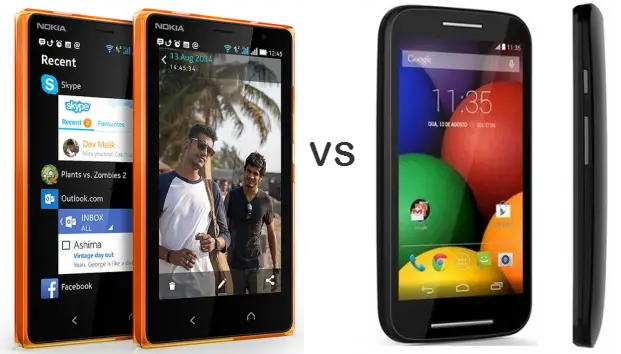Display and Processor
The display size for both smartphones is similar at 4.3 Inch but the Moto E display flaunts IPS LCD display panel with better qHD, 960 x 540 pixel resolution, which makes it sharper. The Nokia X2 will feature Nokia’s Clear Black technology which employs polarization filters to reduce reflection between display layers for better colors and outdoor visibility. Also, the display won’t be as durable as the one on Moto E with Corning Gorilla Glass 3 protection. The chipset used in both smartphones is same Snapdragon 200 dual core clocked at 1.2 GHz, but we expect Moto E to be more fluid in terms of UI interaction as it’s running stock Android 4.4 Kitkat operating system unlike Nokia X2 with heavily customized tiled interface.
Camera and Internal Storage
The imaging hardware is where Moto E stutters and Microsoft plans on exploiting this Moto E short coming with a 5 MP Auto focus rear camera on Nokia X2 aided with a front camera for video calling. Moto E on the other hand sports a lone 5 MP fixed focus shooter at the rear, without LED flash support and with dismal performance. Internal storage is again same on both devices with 4 GB on board storage, expandable up to 32 GB using MicroSD card slot. Microsoft could have gained an easy advantage by adding at least 8 GB storage.
Battery Operating System and Other Features
Both Nokia and Motorola phones have fared quite well in this department so far and these two are also expected to follow the legacy. Moto E comes with 1980 mAh battery capacity which gave us more than decent backup in our time with the device. Nokia X2 comes with slightly lower 1800 mAh storage which will give you cellular browsing time of 4 hours, according to Nokia.
Recommended: How Android OS running on Nokia X is Different from Regular Android Phones
Moto E runs on latest Android 4.4 KitKat which is quite smooth and supports all apps and services from Google Playstore. Nokia X2 on the other hand will have a custom Windows Phone like interface on top of Android 4.3 jelly bean AOSP with support from third party app stores. You can side load apps and use HERE maps for online/offline navigation. Both phones support Dual SIM functionality.
Key Specs
Conclusion
Moto E will provide you with a better Android experience and will come cheaper. Nokia X2 will have the advantage of better imaging hardware and the well established Nokia after sales support. In case imaging hardware ranks higher on your priority list, go for Nokia X2, for all other stuff Moto E won’t disappoint you.
